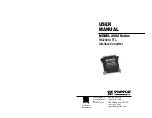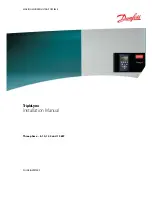
– 13 –
6.
RANGE OF APPLICATIONS
Generally, the power rating of an electrical appliance indicates the amount of work that can be done by it.
The electric power required for operating an electrical appliance is not always equal to the output wattage
of the appliance. The electrical appliances generally have a label showing their rated voltage, frequency,
and power consumption (input wattage). The power consumption of an electrical appliance is the power
necessary for using it. When using a generator for operating an electrical appliance, the power factor and
starting wattage must be taken into consideration.
In order to determine the right size generator, it is necessary to add the total wattage of all appliances to
be connected to the unit.
Refer to the followings to calculate the power consumption of each appliance or equipment by its type.
(1)
Incandescent lamp, heater, etc. with a power factor of 1.0
Total power consumption must be equal to or less than the rated output of the generator.
Example:
A rated 3000 W generator can turn thirty 100 W incandescent lamps on.
(2)
Fluorescent lamps, mercury lamps, etc. with a smaller power factor
Select a generator with a rated output equivalent to 1.2 to 2 times of the power consumption of the
load.
Example:
A 400 W mercury lamp requires 600 W to 700 W power source to be turned on.
A rated 3000 W generator can power four or five 400 W mercury lamps.
NOTE 1: If a power factor correction capacitor is not applied to the mercury lamp or fluores-
cent lamp, the more power shall be required to drive those lamps.
A rated 3000 W generator can drive one or two 400 W mercury lamps without power
factor correction capacitors.
NOTE 2: Nominal wattage of the fluorescent lamp generally indicates the output wattage of
the lamp.
Therefore, if the fluorescent lamp has no special indication as to the power con-
sumption, efficiency should be taken into account as explained in Item (5) on the
following page.
(3)
Motor driven tools and light electrical appliances
Generally the starting wattage of motor driven tools and light electrical appliances are 1.2 to 3 times
larger than their running wattage.
Example:
A rated 250 W electric drill requires a 400 W generator to start it.
(4)
Initially loaded motor driven appliances such as water pumps, compressors, etc.
These appliances require the large starting wattage which is 3 to 5 times of running wattage.
Example:
A rated 900 W compressor requires a 4500 W generator to drive it.
NOTE 1: Motor-driven appliances require the aforementioned generator output only at the
starting.
Once their motors are started, the appliances consume about 1.2 to 2 times their
rated power consumption so that the excess power generated by the generator can
be used for other electrical appliances.
NOTE 2: Motor-driven appliances mentioned in Items (3) and (4) vary in their required motor
starting power depending on the kind of motor and start-up load. If it is difficult to
determine the optimum generator capacity, select a generator with a larger capac-
ity.
GENERATOR_GS2380.fm 13 ページ 2007年10月1日 月曜日 午前9時13分
Summary of Contents for ROBIN RGD3300H
Page 1: ...SERVICE MANUAL RGD3300H RGD5000H GENERATORS Models PUB GS2380 Rev 06 08 ...
Page 2: ......
Page 53: ......
















































